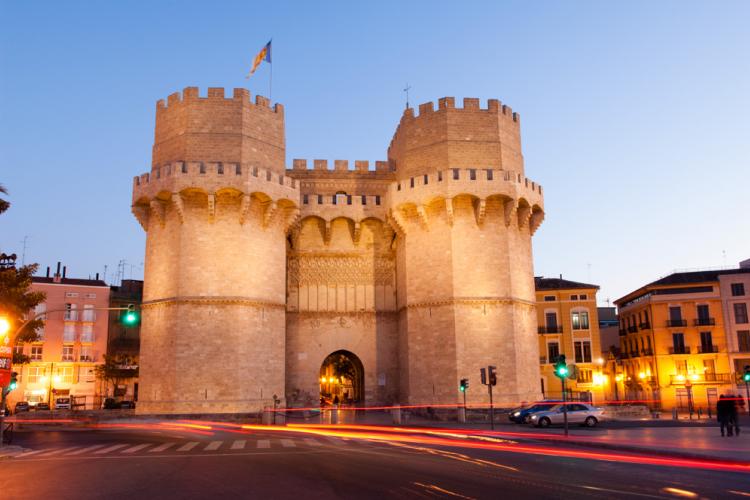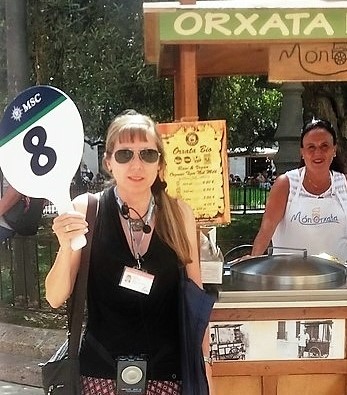Torres de Serranos, the main entrance to Valencia in Medieval times
The Serrano’s gateway was part of the Christian’s walls, that were built in the 14th century, which opened up to the people of the north. There were 12 gates however they were torn down in the 19th century to widen the growth of the city. Fortunately there were two gates saved the Quart Towers and the Serrans gateway as they had other functions such as a prision.
The main Gateway into the city
The main gateway opened in front of the road to Sagunto, which was the main entrance to Valencia from the north. It was the gateway through which those arriving from Aragon, Catalonia and other northern kingdoms and regions of Europe entered the city. Its access gave way, along Serrano’s street, to the parishes of San Bartolomé -which the bell tower still remains – San Lorenzo, San Nicolás, and the square now Manises square, with the religious and political centre of the city.
It was built to replace the previous gateway known as dels Roters, that was built in 1356. Today we can confirm that this gateway was none other than the old Islamic Bab-al-Qantara gateway. They remained standing during the Castilian sieges from 1362 to 1364 under the name Portal de Alcántara. Teixidor presents it as an access defended by a tower on top of which a bell was placed. Perhaps it is the same bell that exists today in the new gateway, or a later refurbishment. According to local historiography, this bell became famous for being the one that warned of the presence of the Castilian army prior to the siege.
Both names coexisted for a time, in a document from 1407 it was called “Portal Nou del Camí de Morvedre” (New Gateway of the way to Morvedre region). The name Serrans, however, is still a matter of debate. This gate gave way towards the Serranía Valenciana-it was the mountains of valencia- but there are also those who argue that a family with the surname Serranos lived in the area.
Originally, the merlons were crowned in a similar way to those of the Lonja de los Mercaderes.
There are two documents, 1401 and 1407, where it is ordered that the Portal de Roteros be demolished, once the construction of the new access was completed, in order to open a square at the foot of it within the walls. This indicates that, in effect, the previous one was located behind the current one, which coincides with the layout of the Muslim wall.

Construction system of The Serrano’s Towers Valencia
Two characteristics qualify his work: magnificent in its design and execution and rapid in its construction. The City Council spared no expense, despite the fact that it was the largest civic gate that had ever been built on the Iberian Peninsula.
Stones were brought from the best quarries in the Kingdom: From the usual Rocafort, from Almaguer and Alginet, and by sea, from Bellaguarda and Benidorm. Also, the famous blue stones from the Saguntine quarries.
In 1402 a document certifies a payment to travel to the north in order to see works of towers and gates, the reference of the Poblet Monastery was was taken into account. But the Portal de San Miguel de Morella seems to be more similar.
We should also look for influence in Francesc Eiximenis, who wrote that each main gate of the city should be between two towers and the highest and largest towers in the four main gates. It fits in with Balaguer’s design, although it is not something new in Valencia, as the Boatella gateway in the Islamic wall would have had the same physiognomy. The Muslims were familiar with the polyorcetic developed by the Romans. In fact, the Porta Saguntina of the Roman wall must also have had this layout.
In conclusion, a lavish “Roman-style” entrance was built, more like a triumphal arch in the classical tradition than an entrance. This would advance by a few decades the Humanism that was already being experienced in Italy.
The towers are polygonal, which is what Vitrubio recommended in his treatises, together with circular towers to the detriment of square towers, which were more vulnerable to attack and less effective in defence.
The background, then, we believe, must be the gate of San Sebastiano and San Paolo of the imperial Roman wall.
Like a triumphal arch
And why a triumphal arch? the reader will ask, and to commemorate what? One is inclined to think that it was to commemorate the double victory of the city against the siege of the Castilian troops in the War of the Pedros that took place between 1356-1369.
From another socio-economic point of view → Valencia was becoming the most powerful commercial city in the Hispanic Mediterranean arc.
If This gate was made, it is because they wanted to do it and because at the time they could pay for it.
Such an early example illustrating the use of the triumphal arch → through the gateway on 26 March 1402, Dña Blanca, daughter of Don Carlos, King of Navarra, entered to marry the infant Don Martín, King of Sicily.

